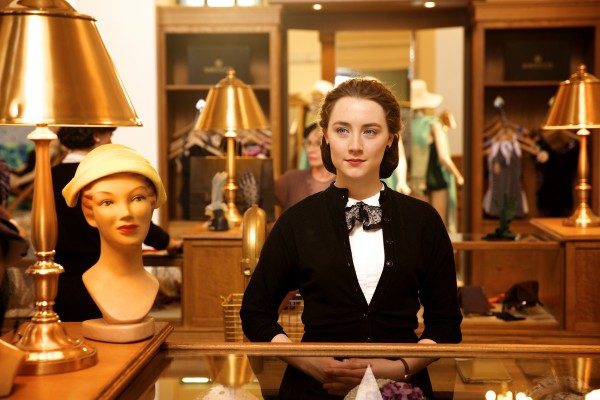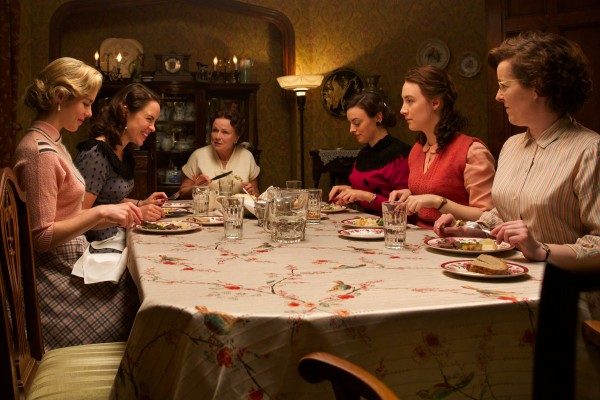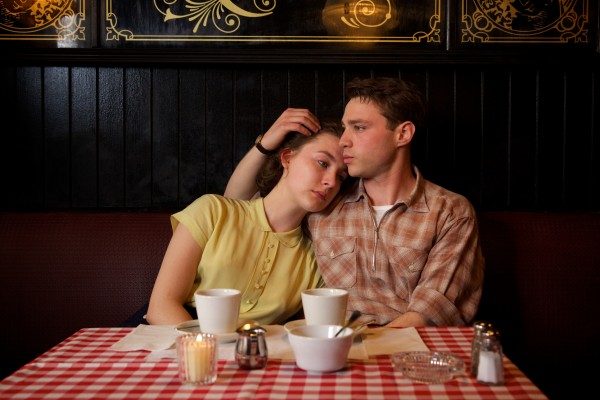

From the moment Saoirse Ronan (The Grand Budapest Hotel) steps on screen as Eilis Lacey in the opening scene of Brooklyn, she is already present as a living, breathing, fully-realized character. This notion is one that permeates the film’s run-time and its overall impression — that this young woman’s story, these characters, and this time period on display are all completely genuine and authentic from start to finish. Not only that, it will likely be the most charming film audiences will see this year.
This romantic drama is set in the 1940s during the Ellis Island immigration influx of the early twentieth century. It is based off the novel by Colm Tóibín and adapted for the screen by Nick Hornby (An Education, Wild). John Crowley, the man behind Andrew Garfield’s (The Amazing Spider-Man) indie breakout in Boy A, directed the period piece.
The story follows Eilis (pronounced Ay-lish), a young woman ready to break out of her small village life in Ireland and head out on her own for Brooklyn, New York. Once there, she experiences all the highs and lows (mostly lows at first) of being away from home for the first time as a stranger in a new land – meekly starting a new job and clumsily making friends all while desperately pining for her family. Her fish-out-of-water existence is interrupted when she meets Tony (Emory Cohen, The Place Beyond the Pines), a local Italian boy who picks her out of the crowd at a weekly Irish dance. With him, she experiences her first romance and begins to come into her own, that is until her presence is suddenly needed by her family back in Ireland. She then finds herself at a crossroads between her old familiar life (with the attentions of a charming local boy, Jim Farrell, played by Ex Machina’s Domhnall Gleeson) and the new adventures waiting for her across the Atlantic.
The greatest triumph of Brooklyn is in its protagonist. Ronan delivers an outstanding portrayal of a young adult woman touting the line between the naiveté and inexperience of youth and the quickly developing maturity required of a plucky immigrant girl striking out on her own in the ‘40s. Ronan carries this role with an old school elegance and quiet strength. She presents to the audience a beautiful portrait of young womanhood, with all its conflicting emotions and excitements of experiencing life’s moments for the first time. The character is forced to mature quickly, but Ronan manages to play Eilis to her depths by never losing sight of the innocent girl we see at the beginning of her story.
As I observed Eilis’ journey, I got the sense that I was witnessing the makings of an iconic character, one that future generations of young women will be ridiculed for relating to so passionately — think Elizabeth Bennet or similarly Holden Caulfield for young men. The best part about Eilis’ story is that she and her experiences are never glamorized by Ronan, Crowley, or Hornby’s script. We see Eilis confront her sentimentality for her past just as we confront that in our parallel experience of watching a charmingly nostalgic period piece. Both she and the story develop in maturity and show the dirty and bleak aspects of growing up sans rose-tinted glasses.
Likewise, Ronan’s supporting cast deliver equally complex performances for characters that are never one-dimensional or shoved to the background. Cohen, who many moviegoers will be seeing for the first time, or at least for the first time as a leading man, makes a star-making debut here and an effortless transition to romantic lead (he had an impressive breakout as Bradley Cooper’s troubled son in The Place Beyond the Pines and played a small role in last year’s The Gambler remake). Gleeson also shines (as he is wont to do) in what little screen time he is afforded. Another performance of note belongs to Julie Walters (many know her as Mrs. Weasley in the Harry Potter series) as Mrs. Keogh — Eilis’ stern, but quick-witted and surprisingly kind-hearted boarding house keeper. When it comes to these supporting characters, the actors along with Hornby’s screenplay allow the audience to empathize with everyone on screen — this even extends to the “giddy girls” living at the boarding house and Eilis’ neglected mother and sister in Ireland. In a subtle stroke of genius, the story even manages to have us emotionally attached to each side of the Tony-Eilis-Jim love triangle, a feat which has eluded countless storytellers throughout decades of filmmaking.
It is likely that many theatergoers will leave this film in appreciation of Hornby’s adaptation of Tóibín’s story. The dialogue has equal parts raw emotion and unexpected but welcome humor (mostly from Tony’s fast-talking and punchy Italian family) as well as a mastery of the period’s idiosyncrasies and sentimentality — i.e. we see the various immigrant cultures transforming New York into its melting pot vision of the American Dream that we still see today. Crowley’s direction, in conjunction with Yves Bélanger’s (Wild) cinematography, also creates a complementary visual portraying a delicate balance between both the beautiful, somber, charming, and gritty moments of this era and Eilis’ experiences.
Verdict: 5 out of 5
It would be immensely difficult for me to find any true fault with Brooklyn. It stays wholeheartedly true to what this Irish girl’s experiences and perspective would be during this time in history and her particular stage of life. Her story is a compelling one, and it adds a dynamic female coming-of-age tale into a genre largely populated by men. Most importantly, the film succeeds in everything it sets out to do. It celebrates the challenges of youth, the freedom of womanhood (minus the politics), and the splendor of first love in a most realistic and authentic manner. I experienced genuine moments of both laughter and tears during scenes that unveiled themselves as organically and true to reality as a fictional story can make possible.




